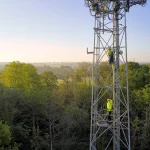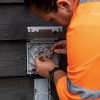BT Launch Narrowband Internet of Things (NB-IoT) network – Covers 97% of UK

Telecoms and broadband giant BT (EE) has today launched a new multi-million-pound Narrowband Internet of Things (NB-IoT) network, which is a low-power and long-range fixed wireless network that claims to cover 97% of the UK’s “outdoor population” (not geography) and will be used to connect sensors or other smart IoT devices.
The new standards-based NB-IoT network is a type of Low Power Wide Area Network (LPWA), which is similar but different from LTE-M and will harness EE’s licensed 1800MHz spectrum band. It can also co-exist with existing 2G, 3G, and 4G mobile networks.
Just to be clear, these aren’t particularly fast networks in terms of data connectivity, which is because their goal is more to support – in a low-cost way – “smart city” style initiatives across industries such as utilities, construction, and the public sector (i.e. connecting tiny – often battery powered – IoT sensors, such as for monitoring water supplies, air quality or embedded in street lighting etc.).
Advertisement
The rollout of the network will allow BT to help fast-track ‘smart cities’ of the future through use cases that include monitoring and optimising energy use, storage, and distribution. The agricultural industry will also stand to benefit from IoT connectivity, with BT having previously trialled sensors to monitor haystack temperature and prevent fire risks, as well as safekeeping of livestock through gate sensors.
Chris Keone, MD of Division X at BT, said:
“Growing numbers of businesses are beginning to realise the benefits of IoT applications, and our UK-wide NB-IoT network opens up a wide range of connectivity solutions for monitors, sensors, and other smart devices. Whether it’s building the smart cities of the future or reducing carbon emissions, our network will provide customers with the reliability and efficiency they need.”
The network will add to BT’s existing IoT portfolio, which includes eSIMs and IoT national roaming SIMs for UK businesses, offering greater connectivity to customers on the move or in remote locations.
Mark is a professional technology writer, IT consultant and computer engineer from Dorset (England), he also founded ISPreview in 1999 and enjoys analysing the latest telecoms and broadband developments. Find me on X (Twitter), Mastodon, Facebook, BlueSky, Threads.net and Linkedin.
ISPA Start Hunt for the Best UK Broadband Providers of 2024 »






















































Nifty – worth noting that Vodafone has had such a network in the UK for a few years now.
Re-inventing the wheel here?
Using an established technology to offer a competing network.
Another potential vulnerability to personal security when hacked.
Too much hype, not enough thought. Again.
Just a low power data network, nothing more sinister.
Wouldn’t a lower frequency be more suitable?
Bloody marketeers.
How about getting the fibre and mobile services properly established, nationwide, with no “Not-spots”, before indulging in “nif-naff and trivia”.
Instead, what does the “Much valued consumer” get . . . a plaguerised version of the 1917s “Dough-boy” song – “Over there” . . . “The installers are coming, the installers are coming . . and we’re not coming back until we’ve over-built over there”.
Split-arse mechanics.
While it may not be improving your mobile or broadband coverage this has value.
But if you cannot rely on it to be universal, it will just end upbeing regarded as yet another burden on your technical ability memory, as to how to use it, with limited use capability. Most people are desirous of one easily portable technical artefact that can do everything (Aren’t the Chinese already going down that road) but in order to “Win” and be omnipresent, it must have near universal support from the inputs it relies on i.e. electrical power and signalling.
UK is a long way off that at the moment.
This is a different kind of network for a different purpose.
Perfect is the enemy of good.
Is this any good for smart meters?
Any details? How do I get a plan? Is it trial only?
Also I’d take a Vodafone plan, but I’ve never been marketed to not found the info. Probably as sole trader.
IoT sims have plenty of use for minor but important data logging, and possibly yeah the smart meter might love it.